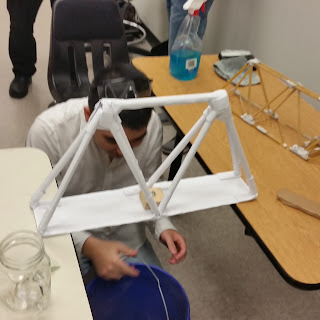Bridge Competition
Bridge can only be made out of any kind of pasta (like spaghetti) and glue (any kind of glue) and string or fishing line.
It needs to span 2 feet, and have room to place a 5cm by 5cm by 2cm loading block on it.
Score = weight it can hold up to 15 kg / weight of the bridge
Beam design:
https://www.quora.com/Why-is-an-I-section-commonly-used-in-beam-design
Truss structure:
Do an image search for "Truss Structures"
→ Make it light weight, if it holds more than 15kg it's over-designed.
Winner gets 100% on the final!
Bridges from past years:
wt: 404g, held 14,600g - 36.14
Beam design!
wt:139 held 1750 - E 12.6
Paper - wt:392g, held 5400 E 13.77
wt: 1048g held>79,500 E>75.85
↑Unbreakable!↑
wt: 141 held 5,000 E 35.46
wt 244g, held 11,150 E: 45.7
wt: 552g, held 11450 E 20.87
wt 263 held 5000 E 19
Creative joints!
wt of bridge: 421, held 8.15kg, efficiency 19.35
Red bridge:
Bridge weight was 421 g, held 4.4kg, efficiency of 10.45
Wt: 208g, held 2.1kg, efficiency 10.1
wt of bridge: 608g, held 2.35 kg, efficiency 3.86
Bridges from previous semesters:
Best Bridges of the AM section:
Grand prize winners!
Quan N. 65.07g held 22,680 g - efficiency of 348 / or 15,000/65 = 230!!!
These top two bridges were so close, that we are now going to call it a tie:
42.15g, held 6.8 kg, efficiency of 161
Quang Le -
124
124
82
Efficiency rating = Weight it can hold (up to 15 kg) / Weight of the bridge
Bridge HW Grade based on:
- 25% Design
- Creativity (your own design? or just something from the internet?)
- Aesthetic appeal
- Homogeneous distribution of weight
- 25% Use of materials (what material did you use, and why?)
- Cost efficiency (the cheaper the better)
- Strength/weight ratio
- bonding agents & designs
- 25% Efficiency rating
- Class weighted; Top 33% = A, next 33% = B, lowest 33% = C
- 25% Adhere to all of the rules
- It's long enough for the span?
- It is able to be loaded with the 5cm loading block?
Prize:
Person with the highest efficiency rating does not have to take the final.
Basic set-up:
A 5cm by 5cm by 2 cm wood block with a hook in the center will support the weight (see the top green arrow)

Weight will be added to your bridge by adding sand to a bucket suspended to your loading block.


3feet span
** Your bridge will need to be slightly longer than what it needs to span! Span = the distance between the tables your bridge will be resting on.
Rules:
- The bridge will just rest on the table surface - you cannot anchor it with duct tape etc.
- Efficiency is determined by your bridge weight, so choose materials carefully!
- Failure will be defined by either the bridge breaking, or deforming more than 5 cm.
- You will need to fully load your bridge in 8 minutes or less.
Tips:
- Pay attention to your joints - make the connections solid!
- Use clothespins, bent hairpins, paperclips, or small C-clamps (from the dollar store) to hold pieces together while it dries:
- Wax paper makes a great building surface - the glue won't stick to it.

- Build it in sections - don't try to build it all at once!
Competition:
TBD
if you are not able to come to the campus for the competition, you can make a video of testing it at home!
Simulation Bridge builder:
There are several online truss solvers - just google "truss solver" and see what comes up! I cannot vouch for what any free software will do to your computer, so the risk is up to you if you want to try out some of the free codes people have posted online.
http://engsci.stevenhe.com/trusssolver
http://mathonweb.com/truss.htm





















































